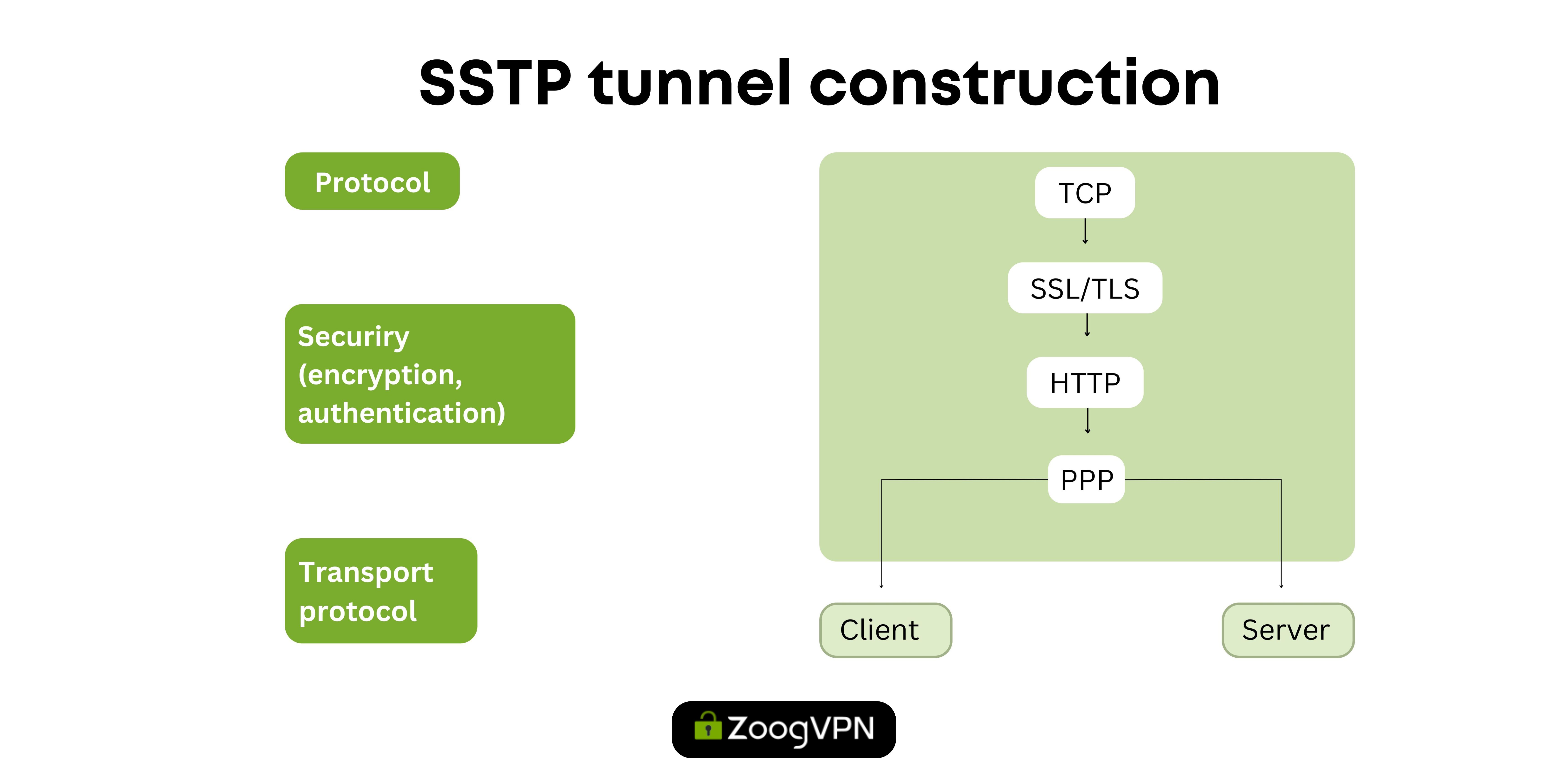SSTP is a well-known VPN protocol that acts as the final communication channel between the client and the server, known for its effectiveness in creating secure remote access to private networks across the vast expanse of the Internet. Want to know if this is the VPN solution you’ve been looking for? Let’s explore its benefits together.
What is SSTP?

SSTP (Secure Socket Tunneling Protocol) is a VPN protocol that establishes a secure tunnel between a client device and a server, primarily facilitating secure remote access to private networks over the Internet. Developed by Microsoft, SSTP was intended to replace the less secure PPTP and L2TP/IPSec protocols, positioning itself as the preferred choice, especially for built-in Windows VPN connections. This protocol, commonly used in VPN connections, operates over SSL/TLS channels over TCP 443 ports, providing reliable security for users in Windows, Linux, and Mac environments.
How does SSTP work?

SSTP works by establishing an encrypted tunnel between the VPN client and the server, protecting data from external interception. Unlike its predecessor PPTP, SSTP uses SSL/TLS and TCP port 443 by default, which increases security and the possibility of firewall evasion. In addition, SSTP prioritizes user authentication over device or computer authentication, which strengthens security measures. When establishing a VPN connection, both the client and the server must support the protocol and agree on a connection. Unlike PPTP, SSTP uses SSL/TLS, which guarantees secure key exchange and encrypted data transmission, thus reducing firewall restrictions. The use of SSL/TLS connections allows SSTP to run on port 443, which is the same as SSL/TLS security standards. Together with the use of user authentication, this makes SSTP the best option for Internet connections that require enhanced security measures. Typically, the client authenticates the connection using the server’s certificate, providing a secure and verified connection over TCP transmission.
How secure is the SSTP protocol?
Introduced in Windows Vista and maintained as a trusted standard in subsequent versions of Windows, such as 7, 8, and 10, SSTP offers a convenient and secure solution for Windows users, effectively protecting against eavesdropping and other potential threats. The widespread use of this solution by many organizations underscores its reliability for encrypted endpoint communications. SSTP includes SSL/TLS in its protocol suite, providing strong cryptographic protection. By using AES cipher, specifically AES-256 encryption, SSTP guarantees a high level of data security. Despite the potential impact of AES-256 encryption on performance, SSTP remains known for its effectiveness in providing fast and secure tunnel communication. In general, SSTP stands out as a highly encrypted protocol that uses SSL/TLS and AES encryption codes to establish and maintain a secure connection between clients and servers, thereby protecting network traffic from potential threats.
Is SSTP only for Windows?
The SSTP VPN protocol is predominantly used in Windows operating systems, utilizing the built-in functionality of the OS to facilitate the creation of VPN connections. SSTP is pre-installed in all versions of Windows Vista and later, which simplifies the user experience for Windows users. However, SSTP does not support alternative operating systems such as Linux, macOS, iOS, and Android. Although there are third-party SSTP VPNs for these platforms, they may require additional setup and configuration.
Pros of SSTP
SSTP has a number of advantages, such as strong security, ease of use, and Windows compatibility, but its closed source design and potential security issues may require careful consideration when choosing a VPN protocol for specific use cases.
| Pros | Definition |
| Decent security using SSL/TLS | SSTP utilizes SSL/TLS encryption, which is a robust and widely trusted encryption protocol, ensuring a high level of security for data transmission. |
| High blocking resistance due to TCP port 443 usage | SSTP operates over TCP port 443, the same port used for HTTPS traffic, making it challenging for network administrators to block, thus enhancing accessibility. |
| Easy to use and configure | Compared to some other VPN protocols like OpenVPN, SSTP is simpler to set up and configure, making it more user-friendly, especially for less technically inclined users. |
| Ability to evade most firewalls | SSTP’s usage of TCP port 443 allows it to bypass many firewalls, enabling users to establish VPN connections even in environments with strict network restrictions. |
| Seamless encryption of Internet traffic for enhanced security | While SSTP is primarily associated with Windows, it can be utilized on other operating systems such as Mac, Linux Mint, Android, and Ubuntu with the assistance of VPN services like PureVPN, expanding its compatibility and accessibility. |
Cons of SSTP
| Cons | Definition |
| It is a restricted source, which limits openness and audibility | SSTP is a closed-source protocol, meaning its source code is not publicly available for review, which may raise concerns about potential vulnerabilities or backdoors that cannot be independently verified. |
| Speculation regarding potential backdoors or security loopholes due to Microsoft ownership | Microsoft’s ownership of SSTP has led to speculation about potential collaboration with government agencies like the NSA, raising concerns about the integrity and security of the protocol. |
| Limited support for user authentication only | SSTP supports user authentication only, which may be restrictive for environments requiring more complex authentication methods, potentially limiting its usability in certain scenarios. |
| Potential slowness due to high level of encryption | The robust encryption used by SSTP, particularly AES-256 encryption, may result in slower connection speeds compared to protocols with less encryption overhead, impacting overall performance, especially on slower networks. |
FAQ
1. Does SSTP use TCP or UDP?
SSTP only works on port 443. OpenVPN can run on any port, including port 443. While most VPN protocols use the UDP protocol by default, SSTP specifically uses the TCP protocol.
2. Is it possible to block the SSTP VPN protocol?
It is possible to block the SSTP VPN protocol by blocking the HTTPS port that the protocol uses. However, since the HTTPS port is usually open on most networks, it is less likely to be blocked than other VPN protocols.
3. How do I set up the SSTP VPN protocol?
The steps to set up an SSTP VPN depend on your particular VPN service. Typically, you will need to download and install the VPN client software and then follow the instructions provided by the VPN service to set up your SSTP VPN connection.
4. What exactly is TSL/SSL?
SSL (Secure Sockets Layer) is a cryptographic protocol used to protect data during transmission between two systems, while TLS (Transport Layer Security) is simply an updated and more secure version of SSL. In general, SSL/TLS is easier to configure than IPSec. Unlike IPSec, SSL virtual private networks are accessed by specific apps, making IPSec less susceptible.



























